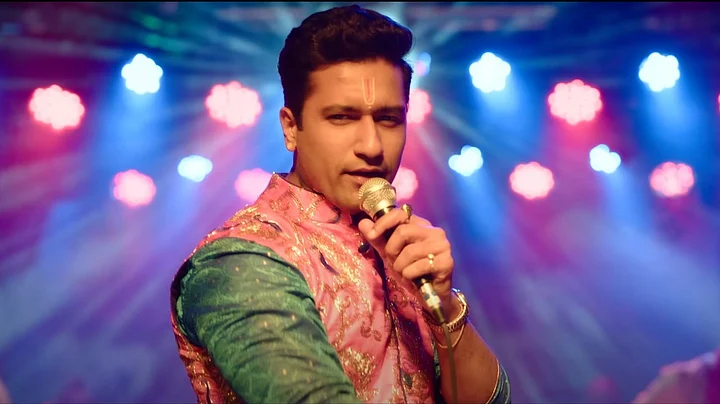Every few days, the iconic dialogue about Hindi-Muslim unity from Krantiveer, resurfaces on social media with many lauding it for its message. The message, though layered, can be boiled down to this – we should, above all else, view the people around us as humans. Humans who are made of the same essential components as each other but are unique because of their experiences, actions, and choices.
This is also what the message of The Great Indian Family, directed by Vijay Krishna Acharya, essentially boils down to.
Ved Vyas Tripathi, the scion of an orthodox Hindu family led by his father Pandit Siyaram (Kumud Mishra), has a knack for music and dance and this makes him a staple at events like jagratas. Ved is to TGIF what Kiara Advani’s character was to Satyaprem Ki Katha, except the former is successful and practically a small-town celebrity.

Vicky Kaushal in a still from The Great Indian Family.
(Photo Courtesy: YouTube)
His life is defined by the responsibility he has to his family and the pressure that comes from being the scion of the Tripathi khaandaan. However, he gets the space to let loose with his two friends, one of whom is troubled by the sight of the woman he likes (Manushi Chhillar as Jasmeet) with another man.
This is where the film introduces its main plot – the three men enter a predominantly Muslim-populated colony in their town and are instantly confronted by their biases.
This internalised bigotry only looms larger in Ved’s life when he finds out that he was born a Muslim man. The film’s best attempt is the exploration of Ved’s insight into how the “differences” he thought existed between people from different religions never actually existed in that way. A laughing Ved remarks, “People buy negativity easily”. A jibe at social media misinformation and the rapid dissemination of hate is astutely made simple.

Vicky Kaushal in a still from The Great Indian Family.
(Photo Courtesy: YouTube)
What is a Bollywood movie without a love story? That’s where Jasmeet comes in. She is presented as a brash, opinionated woman in a film surrounded by its men. Chillar plays the role well but her characterisation is so paper-thin that the character becomes unforgettable. So do most of the other female characters in the film – they all get one-line characteristics even though the actors assigned to the roles (Alka Amin and Sadiya Siddiqui for instance) would’ve pulled off so much more with ease. Srishti Dixit as Ved’s sister gets some moments to shine and her grasp on comedic timing is on full display.
I understand that the film is also trying to make a point about family dynamics but if it had moved away from the idea of a ‘family’ being formed by people born into or married into one, the point would’ve been much stronger.
Most of the heavy-lifting is on Vicky Kaushal’s shoulders and boy, does he shoulder it well. Torn between his family and the way his life is changing, Kaushal portrays emotions with inimitable skill; it’s reminiscent of Masaan. Mishra and Manoj Pahwa (as Ved’s uncle) are both remarkable on screen, to nobody’s surprise. Any screen time they share in any combination results in some of the film’s most effective scenes.

A still from The Great Indian Family.
(Photo Courtesy: YouTube)
The Great Indian Family, however, does fall into the Dream Girl trap of trying to weave an important message into a story without a firm grip on nuance. The former has its heart in the right place – in an increasingly polarised world, The Great Indian Family is attempting to present an argument against religious extremism and bigotry and for the most part, it does so well.
But as is the problem with Acharya’s previous films, the climax just doesn’t tie the film together well enough. The inconsistent screenplay would’ve been forgivable because of the performances and the wonderful way the cinematographer and editor have constructed the small-town hustle and bustle if the climax was powerful.
At first, I thought the climax fell short because it’s preachy but sometimes hammering home a good message becomes essential.

Vicky Kaushal and Srishti Dixit in a still from The Great Indian Family.
(Photo Courtesy: YouTube)
But I later realised that the climax feels more hammy than preachy. It is so highly dramatised that it forgets the film’s own setting. People who have arrived in a mob in the quest for “truth” stand silently and listen to the hero’s monologue. The ‘people can change’ messaging needed a lot more nuance than this film afforded.
(At The Quint, we question everything. Play an active role in shaping our journalism by becoming a member today.)

